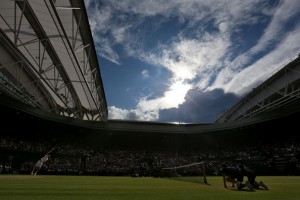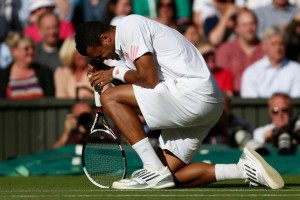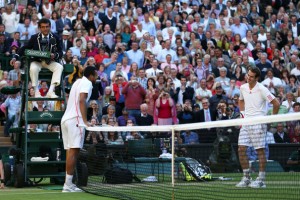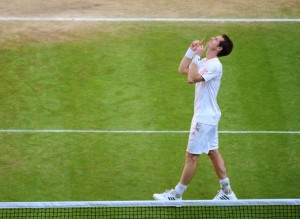Wimbledon, Semifinals
(4) Murray d. (5) Tsonga, 6/3 6/4 3/6 7/5
It was raining when the first of the Wimbledon semifinals commenced, a curious meteorological phenomenon that saw the tournament organisers make the unprecedented decision of closing the roof before play started. This signalled a radical departure from their earlier policy, which had been to consult the resident haruspex, and then do nothing. In any case, having begun that way, they were obliged to end that way. (The extent to which this aided Federer is arguable.  He remains the reigning and uncontested monarch of roofed tennis, but this owes as much to the consistent low bounce than to the absence of curious meteorological phenomena like drizzle and zephyrs. Indian Wells was merely the most recent display of his aptitude in high winds.)
He remains the reigning and uncontested monarch of roofed tennis, but this owes as much to the consistent low bounce than to the absence of curious meteorological phenomena like drizzle and zephyrs. Indian Wells was merely the most recent display of his aptitude in high winds.)
During the break between matches the roof cracked open, and a dazzling line of sunshine began to expand and encompass the court. The camera tilted up, revealing a clearing sky, with vast and surely edible cumulous towers rolling through a field of Titian blue (dissolving cirrus wisps arrived later). It seemed like an omen. No one could say for whom, unless they were British, in which case it was assumed that it would necessarily favour Andy Murray’s opponent, regardless of who that might be. With minutes to go before the players appeared on court, ripples of speculation furrowed outward across the Wimbledon grounds, betting markets quivered, and otherwise stiff upper lips trembled. Murray’s Mound – the traditionally alliterative hillock upon which British fans congregate in order to celebrate their compatriots’ semifinal failures – had been awash with umbrellas during Federer’s victory, but these had vanished. The mood remained upbeat, for all that the introduction of weather would clearly favour Jo-Wilfried Tsonga, as would the location, the scoring system and the gods, busy elsewhere. Murray had not reached a Wimbledon final in 74 years, back when his name was apparently Bunny. (It’s possible I wasn’t paying close attention, and Simon Reed was rather going on.) Nor had any Frenchman contested a Wimbledon final in 15 years, since Cedric Pioline pushed Pete Sampras for almost four games. But one of them – Murray or Tsonga – would be obliged by fate and the propulsive structure of tournament play to progress, unless they formed a gentleman’s agreement not to, thereby voiding all betting markets.
Through the first two sets, Murray’s demeanour remained gentlemanly and collected even as he carved his opponent to pieces. He was impeccable on serve, fleet over the hardening turf, and deft and stylish on passing shots. No trip forward was safe for Tsonga, especially if he strove to gain the forecourt behind his serve. Murray’s returning was everything that Djokovic’s hadn’t been short hours earlier. Tsonga pulled off some impressive half-volleys, despite a curiously brickish technique, but having to do so repeatedly was only going to end one way.  And it quickly became apparent that giving Murray a forehand pass to run at was suicidal, except to Tsonga, who lacks a coach to explain to him that the law of averages isn’t a thing, at least within the context of a tennis match. Murray can make those shots all day, and set about proving it.
And it quickly became apparent that giving Murray a forehand pass to run at was suicidal, except to Tsonga, who lacks a coach to explain to him that the law of averages isn’t a thing, at least within the context of a tennis match. Murray can make those shots all day, and set about proving it.
The mood on Murray’s Mound rose, although it was as ever laced with dread. After all, how can British hearts be broken if Murray didn’t first build a lead? Those who have never known hope cannot know true despair. The dread deepened in the third, as the Scot’s momentum slackened. This is traditionally his cue to fade away entirely, although it was worth pointing out that he traditionally faces Rafael Nadal at this stage. This was merely Tsonga, who had never displayed any aptitude for unlikely comebacks from two sets down at Wimbledon. The English commentator helpfully reminded us of Tsonga’s unlikely comeback from two sets down at Wimbledon last year, against Federer, thereby dialling up the native dread up to a more acceptable level.
Well behind, Tsonga’s endeavours grew reckless, and for a while it paid off, although he still spent a lot of time lounging on the grass watching winners curl by. He spent even more time there, doubled over, after Murray probed the Frenchman’s crotch with frankly ungentlemanly vigour, thus guaranteeing a welter of ball-related puns across various forms of social media, and later proving that American tennis sites are uncomfortable with the word ‘testicle’, either singularly or in the plural. Naff euphemism abounded. Although Tsonga did recover sufficiently to serve out the third set, he was clearly discomfited, and for a time at the beginning of the fourth set his decision-making went awry, although he has admittedly spent his career demonstrating a capacity to make poor decisions without first undergoing blunt-force castration.  He blew a useful chance to maintain momentum in the fourth with some ill-advised two-fisted backhands, and sought to correct this by removing his left hand from the racquet, which didn’t help at all.
He blew a useful chance to maintain momentum in the fourth with some ill-advised two-fisted backhands, and sought to correct this by removing his left hand from the racquet, which didn’t help at all.
Murray, unusually unflappable astride a surge of national terror, was again on top, although he couldn’t quite gain the vital break. But then, with Tsonga serving at 5/6, the Scot pounced, and English, sorry British, hearts quailed at the reality that he might actually win. Tsonga dumped a simple volley into the net, and it was 15/40. Cometh the hour, cometh the return, and the grinding hours of Ivan Lendl’s tutelage bore fruit with a last, fearless forehand crosscourt, dispatching a worthy Tsonga slider onto the far sideline. Murray dropped his racquet and pressed his hands to his face. But it was called out. The call had been swallowed in the roar, but it was there. Eventually Murray challenged, after a sufficient delay that British fans should give thanks that Kader Nouni wasn’t presiding. Tsonga lent on the net, flashing his beautiful smile. Murray grinned back, a study in raw anxiety. Hawkeye revealed an elliptical white dot smeared across the outer half of a line. Centre Court erupted, and the players embraced. Murray lifted his face to the sky, and ambled out into the middle of the playing surface, fighting a private battle to dam the tears spilling over. The United Kingdom allowed itself a moment’s respite from its indefatigable consternation, but Murray, somehow, was alone, gazing straight up.
The broadcasters didn’t allow the moment to last. A statue of Fred Perry appeared on screen, accompanied by a reminder that Murray would face Federer in the final. A long day has passed since then, and the elation has already been revised downward, and given way to the certainty that Murray will not beat the Swiss. Some have suggested that his only chance lies with having the roof open, sunlight apparently being Federer’s kryptonite. I’m neither overly convinced by Federer’s clear favouritism, nor by the delicacy of his calibration. Really, the idea that Federer’s serve is so much more potent indoors has little statistical basis in fact, for all that Richard Krajicek, writing in The Guardian, insists otherwise.  Of course, everyone’s serve is aided by still conditions, but Federer has repeatedly demonstrated that his serve is less affected by wind than other players. Recall the US Open quarterfinals in 2010, when he carved through Robin Soderling as though they weren’t conducting the match in a gale.
Of course, everyone’s serve is aided by still conditions, but Federer has repeatedly demonstrated that his serve is less affected by wind than other players. Recall the US Open quarterfinals in 2010, when he carved through Robin Soderling as though they weren’t conducting the match in a gale.
No, I expect the match to be close regardless of whatever doom might be divined from the entrails, whether the roof is open, closed, or on fire. It will be close because I suspect Murray is no longer the same man as the one who lost nine straight sets in major finals. I don’t know if he will win, since Roger Federer is actually pretty good at tennis, and is pursuing some fairly important goals of his own. But I know he can win, and I have a feeling we will be treated to the finest Wimbledon final since 2009. If that inspires any hope, beware. That way lies despair.
